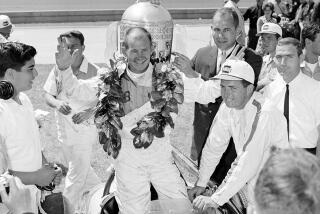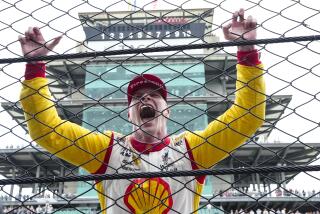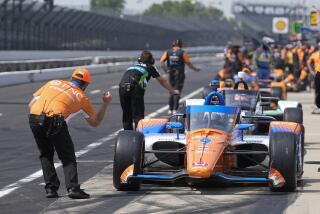Less Room for Error as Indy Speeds Go Up
INDIANAPOLIS — At an average speed of more than 212 m.p.h., Roberto Guerrero knows there is no room for error at the Indianapolis Motor Speedway.
“But,” he adds, “there was no room for error at 200, either.”
While they don’t equate the phenomenal speeds they are reaching in practice for this year’s Indianapolis 500 with a typical Sunday drive, most of the racers agree with Guerrero, last’s year’s runner-up as a rookie. There’s just not that much difference, they say, between driving an Indy car at 200-210 m.p.h., last year’s typical straightaway speed, and the 215-225 m.p.h. they are hitting on the back straight this year.
“You still see things pretty much the same way, whether you’re driving 200 or 210,” said Bobby Rahal, one of the fastest in practice this year for the May 26 race. “And the cars really are pretty quiet, compared to some other types of race cars. All you hear is the engine and some wind noise, but it’s not too bad.
Rahal says he knows when his speed drops by the “note” of the engine and the pull of gravity.
“The ‘G’ forces are less on you at 200 than at 210 or 212,” he said, “but it’s pretty tough to tell the difference when you’re talking 2 or 3 miles per hour.”
Rahal, driving a new March racer in his fourth year at Indy, said his top speeds in the front straightaway have been up to 218-219 m.p.h., while his fastest numbers on the back straight have been 222-223.
“So we’re averaging maybe 220 in the straight lines and still averaging over 200 in the corners,” he said. “Actually, the biggest thing is the handling. That can make all the difference, no matter what speed you’re driving.
“These cars are a whole lot different aerodynamically from the ones we were driving when I came here (in 1982). They’re better and easier to drive faster. But you still have to have them running right to get the speed out of them.”
Guerrero agreed.
“My car is running better now, more comfortable on laps of 210 and 212 than it was last year when I was going 207,” he said. “The cars have better aerodynamics and they are just easier to drive. The one thing a driver must realize is that there is no room for error here at the speeds we’re running.”
Johnny Rutherford has felt the pain of making an error here, crashing twice in practice for the 1983 race and coming away with a broken ankle and a fractured foot. But the three-time Indy winner doesn’t blame rising speed for his misfortune.
“Things happen very quickly at the speeds we’re running now,” Rutherford said. “Two-hundred-and-12 miles per hour--that’s whistling.”
More to Read
Go beyond the scoreboard
Get the latest on L.A.'s teams in the daily Sports Report newsletter.
You may occasionally receive promotional content from the Los Angeles Times.










